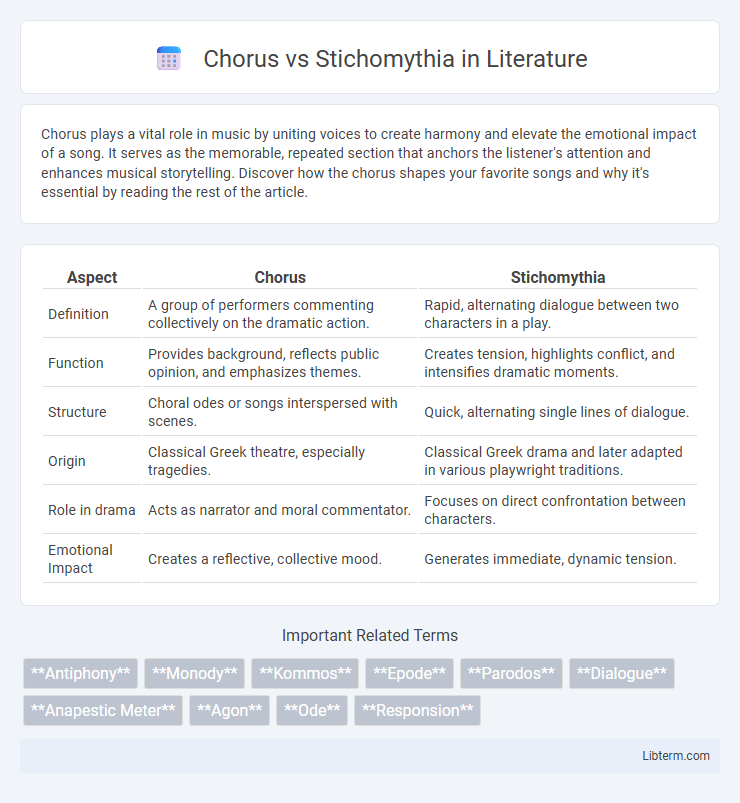Chorus plays a vital role in music by uniting voices to create harmony and elevate the emotional impact of a song. It serves as the memorable, repeated section that anchors the listener's attention and enhances musical storytelling. Discover how the chorus shapes your favorite songs and why it's essential by reading the rest of the article.
Table of Comparison
| Aspect | Chorus | Stichomythia |
|---|---|---|
| Definition | A group of performers commenting collectively on the dramatic action. | Rapid, alternating dialogue between two characters in a play. |
| Function | Provides background, reflects public opinion, and emphasizes themes. | Creates tension, highlights conflict, and intensifies dramatic moments. |
| Structure | Choral odes or songs interspersed with scenes. | Quick, alternating single lines of dialogue. |
| Origin | Classical Greek theatre, especially tragedies. | Classical Greek drama and later adapted in various playwright traditions. |
| Role in drama | Acts as narrator and moral commentator. | Focuses on direct confrontation between characters. |
| Emotional Impact | Creates a reflective, collective mood. | Generates immediate, dynamic tension. |
Introduction to Chorus and Stichomythia
Chorus in ancient Greek drama functions as a collective voice that comments on the action, providing context, emotional depth, and moral reflection through synchronized speech and movement. Stichomythia is a dialogue technique characterized by rapid, alternating single lines of verse between characters, creating dynamic tension and emphasizing conflict or debate. Both serve crucial dramatic roles, with Chorus shaping audience perception and Stichomythia intensifying interpersonal exchanges.
Defining Chorus in Dramatic Literature
The Chorus in dramatic literature functions as a collective group that comments on the play's action and themes, often representing the societal or communal voice. It serves to provide background information, reflect public opinion, and heighten the emotional atmosphere without engaging in direct dialogue. Unlike Stichomythia, which is characterized by rapid, alternating lines between characters, the Chorus offers unified, lyrical passages that guide the audience's understanding of the unfolding drama.
Understanding Stichomythia: A Dramatic Dialogue Technique
Stichomythia is a rapid, alternating dialogue technique used in classical drama to heighten tension and highlight conflict between characters through concise, single-line exchanges. Unlike the broad communal voice of the Chorus, stichomythia emphasizes direct, immediate interaction, allowing playwrights such as Sophocles and Euripides to sharpen emotional intensity and clarify opposing viewpoints in real time. This method crafts dynamic scenes that reveal character motivations and escalate dramatic suspense within a compact, rhythmic verbal duel.
Historical Origins of Chorus and Stichomythia
Chorus originated in ancient Greek theatre as a communal group that provided background information, thematic commentary, and emotional resonance during dramatic performances, dating back to the 6th century BCE. Stichomythia emerged later as a technique in classical Greek tragedy and comedy, characterized by rapid, alternating single lines of dialogue between characters to heighten tension and showcase verbal conflict. Both forms evolved from early Greek theatrical traditions but served distinct narrative and stylistic functions in classical drama.
Functions of the Chorus in Classical Drama
The Chorus in classical drama functions as a narrative bridge, providing contextual background and reflecting public opinion within the play, contrasting with Stichomythia's rapid exchange of dialogue that intensifies conflict between characters. By commenting on the action and expressing collective emotions, the Chorus guides the audience's interpretation and moral perspective. These elements enrich storytelling by integrating communal insight and rhythmic structure, distinguishing the Chorus's role from the terse, confrontational nature of Stichomythia.
The Role of Stichomythia in Dramatic Tension
Stichomythia is a rapid exchange of single lines between characters that heightens dramatic tension by creating a sharp, confrontational rhythm, intensifying conflict and emotional stakes in dialogue. Unlike the chorus, which often provides background, commentary, or reflection, stichomythia thrusts the audience directly into the immediacy of character interaction and argument. This technique compels viewers to experience the urgency and volatility of the moment, amplifying the play's psychological complexity.
Key Differences Between Chorus and Stichomythia
Chorus in classical Greek drama functions as a collective voice providing background information, thematic commentary, and emotional resonance, often speaking in unison or lyrical verses. Stichomythia is a rapid-fire dialogue technique between two characters, characterized by alternating single lines that heighten dramatic tension and sharpen conflicts. While chorus offers generalized reflection and narrative context, stichomythia delivers focused, immediate character interaction and verbal sparring.
Examples of Chorus Usage in Famous Plays
Chorus usage in famous plays like Sophocles' "Oedipus Rex" and Euripides' "Medea" illustrates its role in providing background information, reflecting public opinion, and enhancing thematic depth. The chorus in "Oedipus Rex" acts as the moral and social commentator, representing the voice of Theban elders reacting to unfolding tragedies, while in "Medea," it expresses the conflict between societal norms and individual emotions. These examples showcase the chorus as a collective character influencing narrative pacing, contrasting with Stichomythia's rapid, alternating dialogue primarily used in intense character confrontations.
Notable Stichomythia Dialogues in Theatre
Notable stichomythia dialogues in theatre, characterized by rapid, alternating lines between characters, are prominently featured in classical Greek tragedies such as Sophocles' "Antigone" and Euripides' "Medea." Unlike the Chorus, which provides collective commentary and background, stichomythia heightens dramatic tension through confrontational exchanges that reveal conflict and emotional intensity. Shakespearean plays like "Hamlet" and "King Lear" also employ stichomythia to emphasize psychological struggle and rhetorical skill within pivotal scenes.
Impact of Chorus and Stichomythia on Modern Drama
The chorus in ancient drama serves as a collective voice that provides commentary, emotional depth, and cultural context, influencing modern theater techniques by inspiring ensemble performances and narrative framing. Stichomythia, characterized by rapid, alternating dialogue, contributes to modern dramatic tension and conflict, enhancing the dynamics of character interaction and verbal combat. Together, chorus and stichomythia have shaped contemporary drama's use of rhythm, pacing, and collective versus individual expression on stage.
Chorus Infographic

 libterm.com
libterm.com